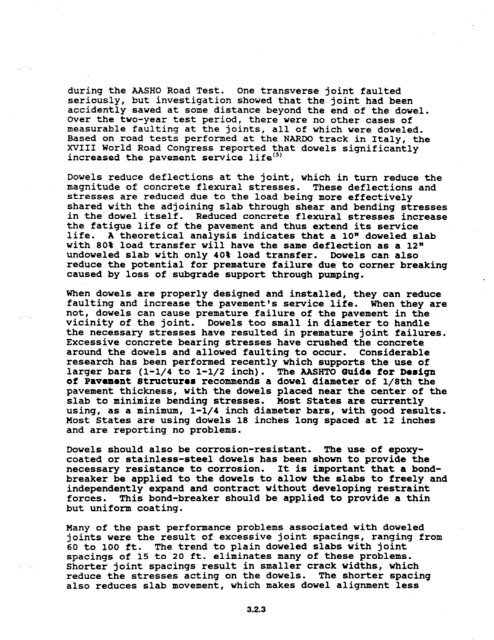chapter 3 rigid pavement - DOT On-Line Publications - Department ...
chapter 3 rigid pavement - DOT On-Line Publications - Department ...
chapter 3 rigid pavement - DOT On-Line Publications - Department ...
You also want an ePaper? Increase the reach of your titles
YUMPU automatically turns print PDFs into web optimized ePapers that Google loves.
during the AASHO Road Test. <strong>On</strong>e transverse joint faulted<br />
seriously, but investigation showed that the joint had been<br />
accidently sawed at some distance beyond the end of the dowel.<br />
Over the two-year test period, there were no other cases of<br />
measurable faulting at the joints, all of which were doweled.<br />
Based on road tests performed at the NARDO track in Italy, the<br />
XVIII World Road Congress reported that dowels significantly<br />
increased the <strong>pavement</strong> service life"'<br />
Dowels reduce deflections at the joint, which in turn reduce the<br />
magnitude of concrete flexural stresses. These deflections and<br />
stresses are reduced due to the load being more effectively<br />
shared with the adjoining slab through shear and bending stresses<br />
in the-dowel itself. Reduced concrete flexural stresses increase<br />
the fatigue life of the <strong>pavement</strong> and thus extend its service<br />
life. A theoretical analysis indicates that a 10" doweled slab<br />
with 80% load transfer will have the same deflection as a 12"<br />
undoweled slab with only 40% load transfer. Dowels can also<br />
reduce the potential for premature failure due to comer breaking<br />
caused by loss of,subgrade support through pumping.<br />
When dowels are properly designed and installed, they can reduce<br />
faulting and increase the <strong>pavement</strong>'s se-ice life. When they are<br />
not, dowels can cause premature failure of the <strong>pavement</strong> in the<br />
vicinity of the joint. Dowels too small in diameter to handle<br />
the necessary stresses have resulted in premature joint failures.<br />
Excessive concrete bearing stresses have crushed the concrete<br />
around the dowels and allowed faulting to occur. Considerable<br />
research has been performed recently which supports the use of<br />
larger bars (l-1/4 to l-1/2 inch). The AASHTO Guide for Design<br />
of Pavement Structures recommends a dowel diameter of l/Sth the<br />
<strong>pavement</strong> thickness, with the dowels placed near the center of the<br />
slab to minimize bending stresses. Most States are currently<br />
using, as a minimum, l-1/4 inch diameter bars, with good results.<br />
Most States are using dowels 18 inches long spaced at 12 inches<br />
and are reporting no problems.<br />
Dowels should also be corrosion-resistant. The use of epoxy-<br />
coated or stainless-steel dowels has been shown to provide the<br />
necessary resistance to corrosion. It is important that a bond-<br />
breaker be applied to the dowels to allow the slabs to freely and<br />
independently expand and contract without developing restraint<br />
forces. This bond-breaker should be applied to provide a thin<br />
but uniform coating.<br />
Many of the past performance problems associated with doweled<br />
joints were the result of excessive joint spacings, ranging from<br />
60 to 100 ft. The trend to plain doweled slabs with joint<br />
spacings of 15 to 20 ft. eliminates many of these problems.<br />
Shorter joint spacings result in smaller crack widths, which<br />
reduce the stresses acting on the dowels. The shorter spacing<br />
also reduces slab movement, which makes dowel alignment less<br />
3.2.3
















